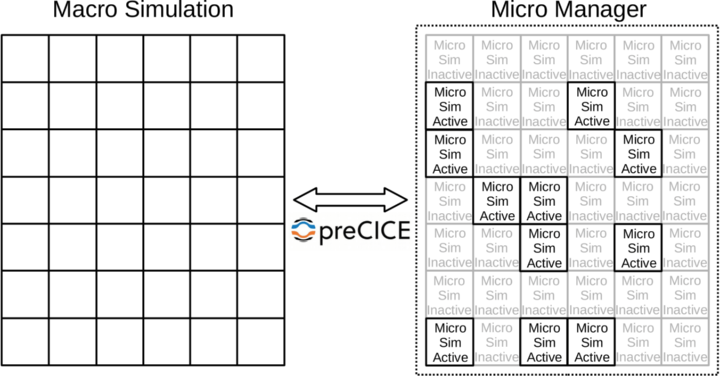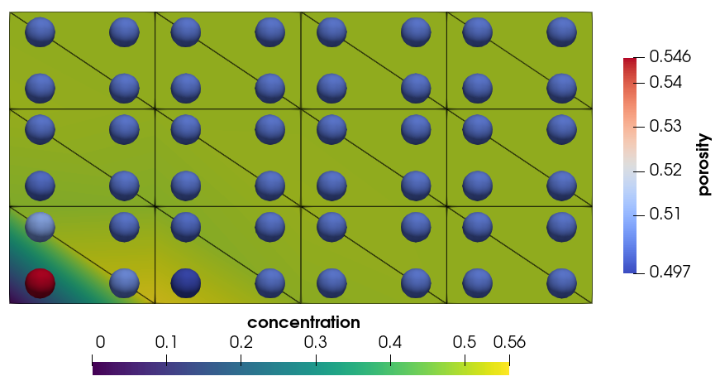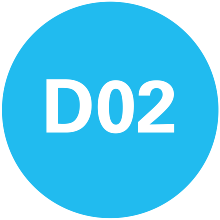People
Alexander Jaust (Former principal investigator in 2022)
Alexander Jaust (Former post-doctoral researcher from 2018 to 2021)
Publications
Conference Papers
- Jaust, A., Weishaupt, K., Mehl, M., & Flemisch, B. (2020). Partitioned coupling schemes for free-flow and porous-media applications with sharp interfaces. In R. Klöfkorn, E. Keilegavlen, F. A. Radu, & J. Fuhrmann (Eds.), Finite Volumes for Complex Applications IX - Methods, Theoretical Aspects, Examples (Vol. 323, pp. 605–613). Springer International Publishing. https://doi.org/10.1007/978-3-030-43651-3_57
- Totounferoush, A., Ebrahimi Pour, N., Schröder, J., Roller, S., & Mehl, M. (2019). A New Load Balancing Approach for Coupled Multi-Physics Simulations. 2019 IEEE International Parallel and Distributed Processing Symposium Workshops (IPDPSW), 676–682. https://doi.org/10.1109/IPDPSW.2019.00115
Journal Articles
- Bringedal, C., & Jaust, A. (2024). Phase-field modeling and effective simulation of non-isothermal reactive transport. Results in Applied Mathematics, 21. https://doi.org/10.1016/j.rinam.2024.100436
- Huber, F., Bürkner, P. C., Göddeke, D., & Schulte, M. (2024). Knowledge-based modeling of simulation behavior for Bayesian optimization. Computational Mechanics, 74, 151–168. https://doi.org/10.1007/s00466-023-02427-3
- Chourdakis, G., Davis, K., Rodenberg, B., Schulte, M., & et mult. (2022). preCICE v2: A sustainable and user-friendly coupling library. Open Research Europe, 2, Article 51. https://doi.org/10.12688/openreseurope.14445.2
- Schmidt, P., Jaust, A., Steeb, H., & Schulte, M. (2022). Simulation of flow in deformable fractures using a quasi-Newton based partitioned coupling approach. Computational Geosciences, 26, 381–400. https://doi.org/10.1007/s10596-021-10120-8
- Rodenberg, B., Desai, I., Hertrich, R., Jaust, A., & Uekermann, B. (2021). FEniCS-preCICE: Coupling FEniCS to other simulation software. SoftwareX, 16. https://doi.org/10.1016/j.softx.2021.100807
- Rüth, B., Uekermann, B., Mehl, M., Birken, P., Monge, A., & Bungartz, H.-J. (2021). Quasi-Newton waveform iteration for partitioned surface-coupled multiphysics applications. International Journal for Numerical Methods in Engineering, 122, Article 19. https://doi.org/10.1002/nme.6443
Published data sets
- Chen, J., Chourdakis, G., Desai, I., Homs-Pons, C., Rodenberg, B., Schneider, D., Simonis, F., Uekermann, B., Davis, K., Jaust, A., Kelm, M., Kotarsky, N., Kschidock, H., Mishra, D., Mühlhäußer, M., Schrader, T. P., Schulte, M., Seitz, V., Signorelli, J., et al. (2024). preCICE Distribution Version v2404.0 [DaRUS]. https://doi.org/10.18419/DARUS-4167
- Jaust, A., & Schmidt, P. (2021). Replication Data for: Simulation of flow in deformable fractures using a quasi-Newton based partitioned coupling approach [DaRUS]. https://doi.org/10.18419/DARUS-1778
- Jaust, A., Weishaupt, K., Flemisch, B., & Schulte, M. (2021). Replication Data for: Partitioned coupling schemes for free-flow and porous-media applications with sharp interfaces [DaRUS]. https://doi.org/10.18419/DARUS-1644
Research
About this project
Many interesting applications in the CRC are multi-physics or multi-scale problems which are coupled via a sharp interface or across two or more spatial scales. Examples for this are the hydromechanical coupling between fluid filled fractures and the surrounding poroelastic matrix or multi-scale simulations of porous media flow, transport and reaction processes. In our project, we tackle such problems by a partitioned coupling approach using separate software components for each subdomain or each scale. The coupling between these components is realized by using our open-source library preCICE which takes care of data communication, stabilisation of the coupling and coupling steering. The main objectives of the project are to (i) contribute to enabling previously infeasible coupled simulations in cooperating projects of the CRC, (ii) use the requirements and challenges defined by these applications to develop novel numerical and software solutions for component coupling, and (iii) to contribute to the sofware output of the CRC in terms of re-usable and easily modifiable simulation environments for reseachers in the CRC and beyond.
Results
Funding Period 1
In the first funding period of the CRC, we had achieved the following goals: (i) We established a mixed-dimensional hydromechanical coupling of liquids injected into fractures with the surrounding deformable porous structure in cooperation with B05 with full support of parallel simulations at previously infeasible resolutions. (ii) The general functionality of preCICE had been further improved by a prototypical implementation of higher-order multi-rate time stepping . In addition, an efficient two-level implementation removing memory-induced problem size and scalability limits of the inter-code communication initialisation has been finished. (iii) New preCICE adapters had been provided to enable easy plug-and-play coupling for frameworks used in the CRC such as DuMUx, PorePy, FuMux and FEniCS. (iv) We had identified a first set of guidelines for the configuration of numerical coupling methods in preCICE based on an analysis of the strength of the coupling between free flow and porous-medium. (v) In coorperation with D01 and D03, a new visualization tool had been implemented defining a reference mesh for comparative visualization of several simulations.
Funding Period 2
In the second funding period, we consolidated the implementation and configuration of quasi-Newton methods provided in our open source library preCICE as fast iterative solvers for strong coupling across different sub systems of a multi-physics or multi-scale simulations. The current state of the methods and their implementation allows for a substantially easier application in various simulations. For the partitioned simulation of hydromechanical fracture opening, an efficient and robust version of mixed-dimensional coupling has been showcased for the coupling between opening fractures and a porous matrix in cooperation with B05. Numerical and software solutions paving the way for the generalisation to closing of fractures and small opening widths have been implemented in preCICE, in particular an efficient handling of dynamic mesh adaptivity in participating solvers during runtime without costly checkpointing.
[1] P. Schmidt, A. Jaust, H. Steeb, and M. Schulte. Simulation of flow in deformable fractures using a quasi-Newton based partitioned coupling approach. Comput. Geosci., 26:381–400, 2022. doi: 10.1007/s10596-021-10120-8. (open access).
The adaptive micro-macro-scale coupling required in several projects such as project A05, B01, or C02 was a new topic in the second funding period. We achieved an efficient realisation of the coupling via preCICE, specifically fora two-scale two-phase flow scenario with A02. With this new coupling, we parallelized the large amount of micro-scale simulations and replaced communication via files with efficient point-to-point message passing. The adaptivity feature provided by the newly developed micro-manager substantially improved the computational efficiency. The first prototype of micro-macro simulations showed that bounded physical values such as saturation or temperature, are not automatically handled properly by quasi-Newton coupling acceleration schemes. We have developed several approaches to tackle this challenge based on re-scaling before and after the quasi-Newton acceleration, under-relaxation of the quasi-Newton update, and changing the order of solvers to couple via unbounded variables.

Coupling software solutions as well as ready-to-use simulation environments were provided in a usable form to the community inside and beyond the CRC.
In total, the preCICE environment now provides adapters for the following codes used within the CRC: DuMUx (used in A01, A02, A05, C01, C04, D03), DUNE (used in B03, C02), FEniCS (used in B04, B05), and OpenFOAM as an optional software to be used mainly for free flow simulations in several projects within the CRC.

Future Work
For the third fundig phase, our main goals are to broaden the applicability of our coupling tools by further enhancing the numerical methods, adding novel components for auto-tuning, and improving the robustness and usability of the respective software components. We break this down into the following goals: (i) Increasing the versatility and usability of the CRC's software ecosystem, for which we will provide the improved open source coupling library preCICE along with additional components such as a micro-simulation manager and several adapter codes. (ii) Establishing efficient coupled simulation setups within the CRC, thus supporting several other projects in the CRC in establishing simulation (and visualization) setups, in particular for hydromechanical fracture opening with enhanced models, multi-scale transport processes, and in-situ multi-scale visualization in space and time. (iii) Development of adaptive numerical coupling methods, where, in contrast to previous work, we will incorporate both additional user specifications about their simulation requirements (such as bounds for physical fields or accuracy requirements for sub-components) and convergence data collected during runtime (such as residuals) to provide optimized adaptivity.
We work toward these goals in four work packages: (i) Hydromechanical fracture opening: Based on the already existing simulation setup using simulation components implemented in FEniCS and coupled via the open source coupling library preCICE, we advance to include additional aspects such as shear stiffness, precipitation and dissolution effects in collaboration with B05. For these new simulations, the values for fracture stiffness vary across several orders of magnitude. This poses new challenges for the discretization and coupling of the poro-elastic matrix and the embedded fractures. (ii) Multi-scale multi-phase flow, transport and reaction simulations: Based on the established new model hierarchy from C02 for combined multi-phase flow and reactive transport processes in porous media and our new multi-scale coupling functionality in preCICE and the micro manager, we will develop highly scalable adaptive multi-scale simulations. This will require improved dynamical adaptivity in the selection of micro-scale simulations, sophisticated load balancing, and run-time adaptivity of accuracy requirements on the micro-scale. (iii) Multi-scale visualization in space and time: Multi-scale effects in space and time challenge state-of-the-art in-situ visualization both in terms of the visualization methods and in terms of their integration into a running coupled simulation. We plan to develop concepts and tools for in-situ interactive multi-scale visualization in cooperation with D02. We will provide efficient solutions for integrating interactive visualization as an additional executable in a multi-scale simulation. (iv) Support and outreach: In addition to scientific paper publications, software and reproducibility data publications will be an essential part of the output of our project, for which we in will collaborate with project INF Beyond the tight collaboration with our main cooperation partners, we will support further projects that need preCICE to enable their multi-physics and multi-scale simulations, in particular A03, B01, B01, and D03.
We contibute to the salt vision and the benchmarks via our tight collaboration with projects in areas A, B, and C (strongl links to B05, C02, weak links to A03, B01, B04), where we enable and improve relevant simulation scenarios for the salt vision. For the bechmarks, we in addition provide several open source software component sthat can be used in a flexible and modular manner in many sceanarios.
Other projects using preCICE
preCICE is being used nationally and internationally in many projects, that contribute to a constant improvement of both the software and the implemented methods for the benefit of all users. Within SFB 1313, the following projects used preCICE: A02, A03, B01, B03, B05, D01, D02. In FP3, we additionally plan cooperations with the research projects C02, B04, D03.
For further information please contact

Miriam Schulte
Prof. Dr. rer. nat. habil.Project Leader, Research Project D02




